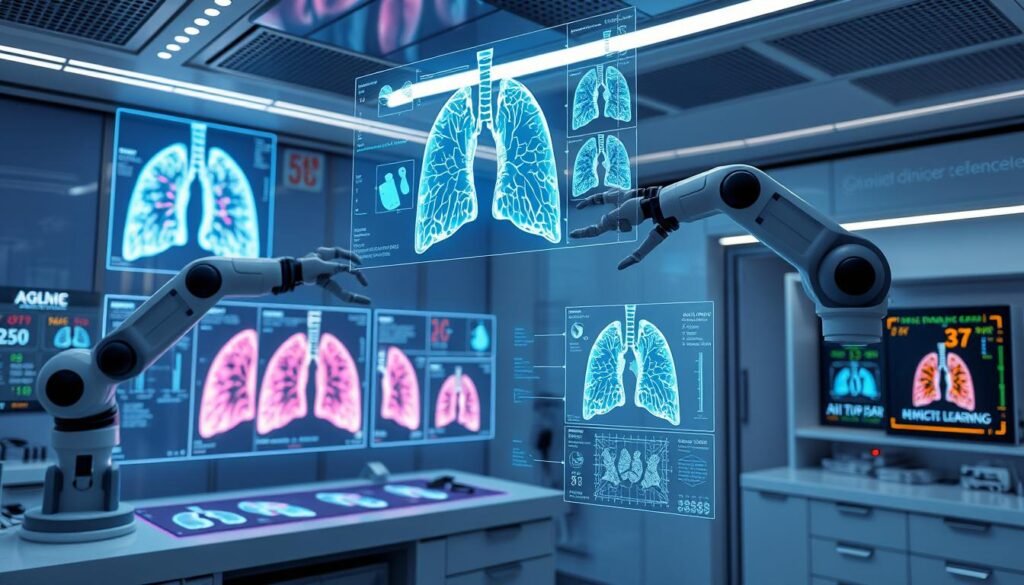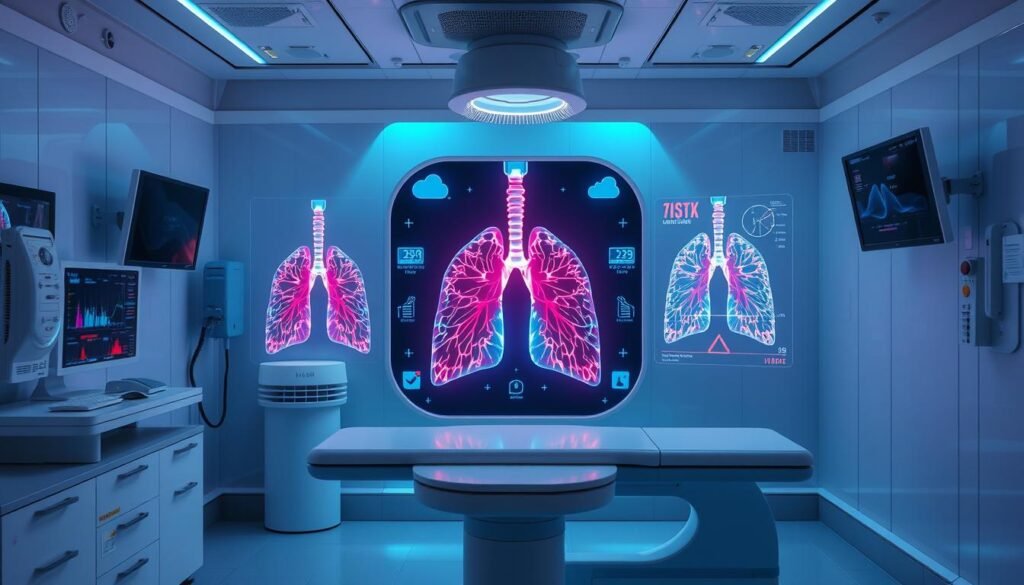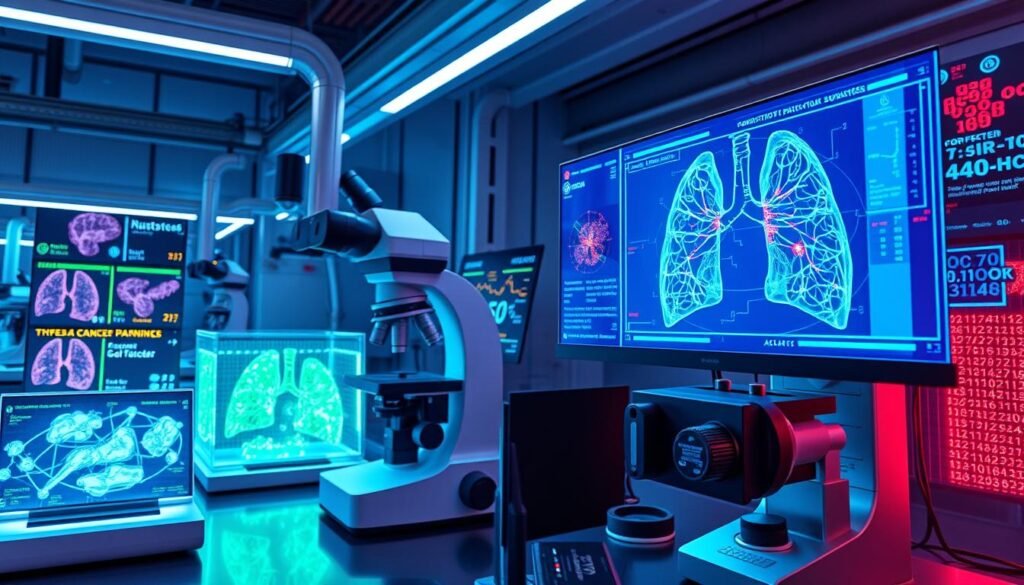Lung cancer is the deadliest cancer around the world. In 2020, it caused 1.7 million deaths. This makes the need for effective ways to assess lung cancer risk very critical. AI is making a big difference here, especially with machine learning. These technologies let health professionals look at lots of health and image data. This helps them find people who are at high risk for lung cancer.
Recent studies show how AI can help find lung cancer early and improve how well treatments work. For example, some models looking at lung scans got scores between 0.75 and 0.81. And tools like Sybil got even higher scores, between 0.86 to 0.94, for their predictions. This shows these tools are good at finding people who might get lung cancer. This helps a lot with managing the disease.
We will look into how AI and machine learning help with assessing lung cancer risk. This could change how well patients do later. For more info on how these new technologies are changing things, check out these studies.
Key Takeaways
- Lung cancer is the leading cause of cancer-related deaths globally.
- AI technologies can enhance early-stage detection rates significantly compared to traditional methods.
- Machine learning algorithms show accuracy levels of up to 98.7% in lung nodule segmentation.
- More than half of women diagnosed with lung cancer are nonsmokers.
- AI models have produced high C-indices and ROC-AUCs, indicating robust predictive capabilities.
Understanding Lung Cancer: A Global Health Concern
Lung cancer is a major problem worldwide. It causes almost a quarter of all cancer deaths. Knowing the facts about lung cancer statistics is key to grasp its huge effect on us all.
Lung Cancer Statistics and Impact
Each year, over two million people are found to have lung cancer. The survival rate is 56% for those caught early. But it drops below 5% for late-stage diagnosis. Sadly, only 16% of cases are found early, making survival much harder.
Most lung cancers are due to smoking, but some non-smokers get it too. Things like radon and asbestos can also cause it. Non-small cell lung cancer (NSCLC) is the most common type. This shows we need better prevention and early detection. Check out more about early detection here.
Current Screening Challenges and Mortality Rates
Screening for lung cancer is tricky. The current tests aren’t always effective or easy to get. Many people find out they have cancer too late. This makes treating the disease harder and leads to more deaths. We need better technology to catch it early and save lives.
Introduction to AI and Machine Learning in Healthcare
Artificial Intelligence (AI) and machine learning are changing healthcare radically. They help analyze big data, aiding in informed decision-making. AI in healthcare does tasks that need human intelligence, like understanding language and recognizing patterns.
Defining AI and Machine Learning
AI is about computer systems doing tasks that need human intelligence. Machine learning lets systems learn from data, improving with time. This learning finds patterns in large data amounts. Healthcare AI is great for things like diagnosing cancer and optimizing treatments. Tasks that took a long time now happen faster, making patient care better.
Significance of AI in Modern Medicine
AI’s impact on medicine is huge. It can automate tasks, letting doctors focus on caring for patients. For example, some AI algorithms diagnose cancer quickly during surgeries. This speed is crucial in urgent situations.
AI has improved mammogram readings for twenty years. A 2019 NCI study showed AI was better than experts at spotting early cervical cancer. These achievements show AI’s accuracy, improving healthcare outcomes.
AI also helps detect cancers like colorectal and prostate cancer more effectively. It aids radiologists in spotting aggressive prostate cancer on MRIs. AI reduces false-positives in lung cancer CT scans, making diagnosis more accurate.
By using AI, doctors can manage patients better and personalize treatments. AI helps pick the best cancer therapies, leading to customized healthcare plans. This shows a big step forward in medicine.
How AI and Machine Learning are Used in Lung Cancer Risk Tools
Technology has greatly changed how we look at lung cancer risk. AI uses machine learning algorithms to examine a lot of data from medical records and scans. This helps doctors find people at high risk of lung cancer more accurately. By analyzing images from low-dose computed tomography (LDCT) and other patient details, these tools improve early cancer detection and help create personalized treatment plans.
The Role of Machine Learning Algorithms in Risk Assessment
Machine learning algorithms are key in accurately assessing lung cancer risk. For instance, the Sybil model is very good at predicting lung cancer risk, with an accuracy between 0.86 and 0.94. It does this by looking at data from over 6,000 scans from the National Lung Screening Trial. Then, it checks its accuracy with different sets of data. This approach changes how risk is assessed, making it better than older methods like Lung-RADS.
Integrating Clinical Data for Better Predictions
Adding clinical data to imaging results makes predictions more accurate. By using details like patient age, smoking history, and past lung screenings, AI models give risk assessments that are more personal. This detailed method not only makes the predictions more trustworthy but also correctly identifies people at low risk. For example, identifying those with only a 0.2% chance of developing lung cancer in the next three years.

Research on these new methods often involves teamwork between major institutions. This increases both how much we know and the effect of the research. Tools like the Sybil model are examples of this effort. They aim to make clinical decisions and the distribution of resources in lung cancer care better.
AI in Lung Cancer Screening
Lung cancer screening has gotten better over time. Now, low-dose computed tomography (LDCT) is the main way to spot the disease early in people at high risk. This method isn’t just cutting down on deaths. It’s greatly improved by AI, making the tests more effective.
By using cutting-edge tech, doctors can find lung cancer more accurately and faster. This brings a big boost in the fight against this illness.
Low-Dose Computed Tomography (LDCT) and AI Applications
LDCT is key for checking lungs, finding issues with less radiation harm. AI steps in to review the scans quickly and with amazing accuracy. Research shows AI can pick out true lung cancer cases with 87% precision, sorting the real ones from the false alarms.

Enhancing Screening Efficiency with AI Models
With lung cancer being a top cause of cancer deaths, better screening is a must. AI, through deep learning, is making screenings more precise. One study showed an AI method with 94% sensitivity and 91% specificity, doing better than older tests.
| AI Model Type | Sensitivity | Specificity | Overall Accuracy |
|---|---|---|---|
| Three-Dimensional Deep Learning | 75% | 82% | 89% |
| SVM-LASSO on LIDC-IDRI Data | 85% | N/A | N/A |
| Customized Mixed Link Network (CMixNet) | 94% | 91% | N/A |
These achievements show how good AI is at lung cancer checks. They also point out the need for common rules to make studies consistent. With these new tools, health care is moving towards more successful lung cancer screenings. This means hope for people who might have this disease.
Advancements in Computational Pathology for Lung Cancer
Computational pathology is changing how we diagnose lung cancer. It is making it faster and more accurate to identify tumors. Adding radiomics lets doctors analyze medical images in detail. This technique is improving how we understand tumors beyond what we can see. It has become key in detecting lung cancer effectively.
Radiomics and Its Impact on Diagnosis
Radiomics pulls detailed data from images like CT scans and MRIs. This lets doctors examine lung tumors closely. It helps distinguish different kinds of lung cancer. Spotting fine details improves diagnosis. It also helps in creating personalized treatment plans for patients.
Utilization of Biomarkers in AI Models
Mixing biomarkers with AI models boosts lung cancer care. Biomarkers help create precise AI algorithms. They improve predictions about the disease. Using both imaging and biomarkers, doctors can plan the best treatments. This combination is a big step forward in fighting lung cancer.

This approach not only improves diagnosis accuracy but also makes doctors’ jobs easier. AI is key in evolving healthcare management. For more detail on lung cancer, see an interesting article here.
Implementing AI in Risk Prediction Models
AI can change how we predict lung cancer, making assessments better. Models like the Back model and PLCOm2012 use AI. They look at different data to find those at high risk for lung cancer.
Current Models and Their Effectiveness
AI in lung cancer risk models is showing good results. These models are accurate thanks to a lot of research. A study looked at over 60 machine learning setups. It found a model that uses age, smoking years, and cigarettes per day to predict lung cancer risk.
This shows you don’t need a lot of info to evaluate lung cancer risks well. Such models could greatly improve how clinicians assess lung cancer risks.
Evaluating AI Performance in Clinical Settings
It’s key to keep testing these models in real-life settings. An important US trial checked how these new models stack up against older ones. Using these models right could lower death rates from lung cancer by 20-24% in those at high risk.
As AI and machine learning change healthcare, these models offer a better chance at catching lung cancer early. This could really help save lives.
| Model | Variables Used | Accuracy | Validation Study |
|---|---|---|---|
| Back Model | Multiple Clinical Factors | High | PLCOm2012 |
| PLCOm2012 | Clinical History, Symptoms | High | US Trial |
| Ensemble Model | Age, Smoking Duration, Cigarettes per Day | Very High | US Trial |
With continuous improvement, these AI models give doctors better tools for lung cancer risk management. This could lead to more efficient and effective care.
Case Studies: Successful AI Applications in Lung Cancer Risk Assessment
AI applications have changed how doctors predict and make decisions about lung cancer. The Sybil tool is very impressive in this field. It uses smart algorithms to study scans from low-dose computed tomography (LDCT). These studies help predict lung cancer risk six years ahead.
Sybil: A Pioneering AI Tool for Lung Cancer Prediction
The Sybil tool is very accurate in predicting lung cancer. It got high scores, showing it works well in figuring out lung cancer risk. The tool can look at huge amounts of data. This helps it make better predictions. Doctors say it’s very useful. In one big study with over 873,000 patients, Sybil could guess who might get lung cancer within a year. It was quite accurate, with a score of 0.88.
Outcomes of AI Integration in Clinical Decision Support
Adding AI to clinical support systems has changed patient care for the better. Studies show how doctors use AI to improve screening and care for patients. Doctors now use guidelines to screen certain smokers annually with LDCT, thanks to AI. This helps find lung cancer early, saving more lives.
The growth of knowledge on lung cancer highlights the need for tools like Sybil. AI helps make detection quicker. It encourages doctors to be more proactive. This means better chances for patients in the long run.
Ethical Considerations and Challenges in AI Implementation
In healthcare’s AI, ethics are crucial, especially in oncology. AI brings challenges, like the black-box problem. This problem is due to complex algorithms hiding how decisions are made. It makes trust hard to build among doctors and patients. Clear explanations of these systems’ predictions are key to gaining trust.
The Black-Box Problem and Trust Issues in AI
The black-box issue means algorithms’ workings are hard to understand. This opacity causes trust problems in AI use. Many doctors doubt AI’s impact on oncology soon. This is because a study found two-thirds of US clinicians feel this way. Questions about independence, fairness, and privacy come up when AI’s logic is hidden. Trust falters if AI suggestions don’t align with doctors’ views.
Need for Transparent AI Models in Healthcare
Healthcare needs transparent AI models. Making AI processes clear can ease ethical worries. The A4R framework suggests principles like relevance and transparency. These principles help tackle issues like safety in AI for oncology. They ensure AI tools benefit all patients fairly. Without clear ethics in AI, health gaps could widen, harming care.
| Ethical Concern | Description | Impact on AI in Healthcare |
|---|---|---|
| Trustworthiness | Reliability of AI recommendations in clinical settings | Influences clinician acceptance and patient trust |
| Transparency | Clarity in algorithm decision-making processes | Enhances understanding and confidence in AI systems |
| Equity | Potential biases in AI tools affecting diverse populations | Risk of worsening health disparities |
| Data Privacy | Patient data handling and security measures | Ensures compliance with regulations and protects patient rights |
| Autonomy | Patient control over health-related decisions | Upholds patient agency and informed consent |
Conclusion
The use of AI to check for lung cancer is a big step forward. Every year, around 1.8 million people worldwide are diagnosed with lung cancer. This makes better screening methods very important.
AI, like the deep learning model Sybil, is showing great promise. It can predict with accuracy and lower the chances of false positives. This helps doctors make better treatment choices for those with this serious illness.
The way we check for lung cancer could really change with these new tools. They use complex algorithms to look at a lot of medical data. This means doctors can better identify who is at risk. It’s a more personal way to help people and guides doctors with strong data.
Research and ethical thinking will be key as we move forward. It’s important that tools like Sybil work well for everyone and are fair. Making sure these AI tools are trusted and clear will help patients feel more confident. It will lead to better care for people at risk of lung cancer.